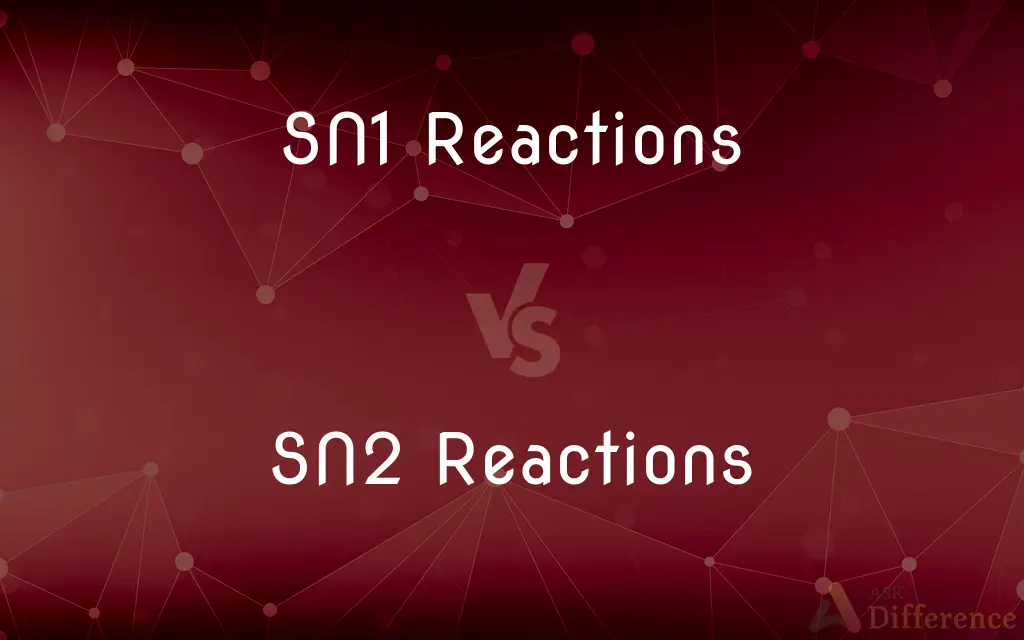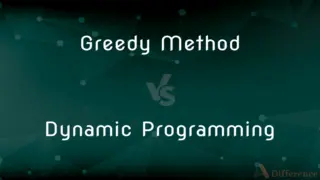SN1 Reactions vs. SN2 Reactions — What's the Difference?
By Tayyaba Rehman — Published on January 6, 2024
SN1 Reactions are two-step nucleophilic substitutions involving a carbocation intermediate, while SN2 Reactions are one-step substitutions where nucleophiles attack and leave simultaneously.

Difference Between SN1 Reactions and SN2 Reactions
Table of Contents
ADVERTISEMENT
Key Differences
SN1 Reactions and SN2 Reactions both represent nucleophilic substitution reactions in organic chemistry. The "S" stands for substitution, "N" for nucleophilic, and the numbers 1 or 2 indicate the molecularity or the number of species involved in the rate-determining step.
In SN1 Reactions, the reaction takes place in two distinct steps. Firstly, the leaving group departs, forming a carbocation intermediate. Then, a nucleophile attacks the carbocation. On the other hand, SN2 Reactions are characterized by a single concerted step where the nucleophile attacks the substrate and the leaving group departs simultaneously.
SN1 Reactions typically occur with substrates that can form stable carbocations such as tertiary carbon centers. Because of this carbocation intermediate, SN1 Reactions often lead to racemization, or a mixture of stereoisomers. Conversely, SN2 Reactions usually occur with primary or methyl substrates and result in inversion of configuration due to the backside attack of the nucleophile.
SN1 Reactions are often favored in polar protic solvents, which can stabilize the carbocation intermediate. These solvents include water and alcohols. In contrast, SN2 Reactions are favored in polar aprotic solvents like DMSO and acetone, which can't form hydrogen bonds with the nucleophile, leaving it more available for the reaction.
The rate of SN1 Reactions is influenced only by the concentration of the substrate, since it's a unimolecular reaction. SN2 Reactions, being bimolecular, have their rate influenced by both the concentration of the substrate and the concentration of the nucleophile.
ADVERTISEMENT
Comparison Chart
Number of Steps
Two-step reaction with carbocation intermediate.
One-step concerted reaction.
Substrate Preference
Tertiary carbon centers.
Primary or methyl substrates.
Stereochemistry
Often leads to racemization.
Leads to inversion of configuration.
Solvent Preference
Polar protic (e.g., water, alcohols).
Polar aprotic (e.g., DMSO, acetone).
Rate Determination
Influenced by substrate concentration only.
Influenced by both substrate and nucleophile.
Compare with Definitions
SN1 Reactions
A unimolecular reaction rate-wise.
The rate of SN1 Reactions depends solely on the concentration of the substrate.
SN2 Reactions
A one-step nucleophilic substitution reaction.
SN2 Reactions involve a simultaneous attack of the nucleophile and departure of the leaving group.
SN1 Reactions
Favored in polar protic solvents.
SN1 Reactions are commonly carried out in solvents like water or alcohols.
SN2 Reactions
A bimolecular reaction rate-wise.
The rate of SN2 Reactions depends on both the substrate and nucleophile concentrations.
SN1 Reactions
A reaction involving the departure of a leaving group followed by nucleophilic attack.
Tertiary carbocations often undergo SN1 Reactions due to their stability.
SN2 Reactions
Favored with primary or methyl substrates.
Methyl halides are often used in SN2 Reactions due to their reactivity.
SN1 Reactions
Often involves racemization.
Due to the carbocation intermediate, SN1 Reactions can produce a mix of stereoisomers.
SN2 Reactions
Results in inversion of stereochemistry.
The backside attack in SN2 Reactions causes an inverted product relative to the starting material.
SN1 Reactions
A two-step nucleophilic substitution reaction.
In SN1 Reactions, the formation of a carbocation intermediate is a key step.
SN2 Reactions
Preferred in polar aprotic solvents.
Solvents like DMSO enhance the rate of SN2 Reactions.
Common Curiosities
How many steps are involved in SN1 Reactions and SN2 Reactions?
SN1 Reactions are two-step reactions, while SN2 Reactions are one-step reactions.
What kind of substrates favor SN1 Reactions?
Tertiary carbocation-forming substrates typically favor SN1 Reactions.
How does stereochemistry change in SN2 Reactions?
SN2 Reactions result in an inversion of stereochemistry.
What solvents are typically used for SN1 Reactions?
Polar protic solvents like water and alcohols are often used for SN1 Reactions.
Do SN1 Reactions produce a mix of stereoisomers?
Yes, SN1 Reactions often lead to racemization, producing a mixture of stereoisomers.
Which reaction type is unimolecular in its rate-determining step?
SN1 Reactions are unimolecular in their rate-determining step.
What do SN1 and SN2 stand for?
SN1 stands for "Substitution Nucleophilic Unimolecular" and SN2 stands for "Substitution Nucleophilic Bimolecular."
Which reaction, SN1 or SN2, is characterized by a backside attack?
SN2 Reactions are characterized by a backside attack of the nucleophile.
Can secondary substrates undergo both SN1 and SN2 Reactions?
Yes, secondary substrates can undergo both, but the reaction type depends on various factors like solvent and nucleophile.
Which reaction is faster with a higher concentration of nucleophile?
SN2 Reactions, as their rate is influenced by both the substrate and nucleophile concentrations.
Why do SN2 Reactions prefer polar aprotic solvents?
Polar aprotic solvents like DMSO make nucleophiles more reactive, enhancing SN2 Reactions.
Do SN2 Reactions involve a carbocation intermediate?
No, SN2 Reactions proceed without the formation of a carbocation intermediate.
Share Your Discovery

Previous Comparison
Greedy Method vs. Dynamic Programming
Next Comparison
Roman Catholic vs. CatholicAuthor Spotlight
Written by
Tayyaba RehmanTayyaba Rehman is a distinguished writer, currently serving as a primary contributor to askdifference.com. As a researcher in semantics and etymology, Tayyaba's passion for the complexity of languages and their distinctions has found a perfect home on the platform. Tayyaba delves into the intricacies of language, distinguishing between commonly confused words and phrases, thereby providing clarity for readers worldwide.













































